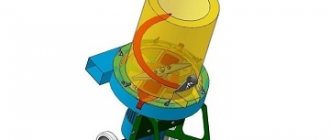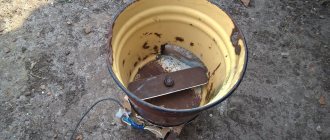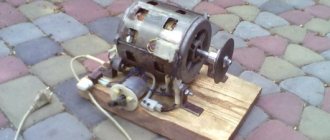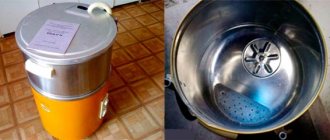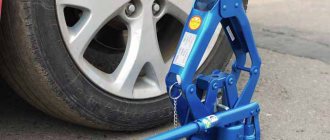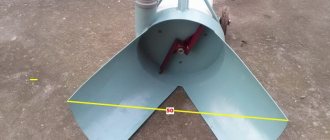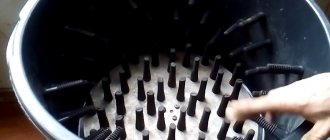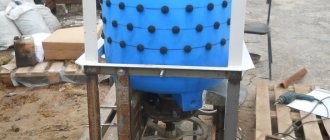How does a plucking machine work?
A homemade feather plucking machine is assembled from a reservoir and rubber parts placed on its inner surface. These parts are called hammer fingers - they are the main part of the device. It is impossible to make these ribbed elements yourself - you have to buy them.
One chicken picker can contain up to 120 beating fingers. Their cost is rather high - on average 20–40 rubles per piece. However, this is the only major expense that will be incurred when creating a homemade product from an old washing machine. Everything else can be found on the farm - a feather plucker assembled with your own hands will cost you little. But the result is excellent: the fuss with plucking will be replaced by an electromechanical installation.
When purchasing pickers, consider the size of the carcasses being plucked. Quail beaters are not suitable for geese, broilers and other larger animals.
Required Parts
The most expensive element for creating a feather removal machine will be the beaters. These parts cannot be replaced with anything, so you will have to order them from a hardware store or specialized enterprises. When ordering these parts, you should decide in advance which carcasses will be processed; the size of the purchased beaters depends on this (larger ones for turkeys, smaller ones for chickens).
The second important element is the washing machine. It must be working. In this case, there is no need to purchase expensive equipment, because it is quite possible to buy a used machine.
Several changes are made to the washing machine; the engine and electrical circuit located at the bottom of the washing tank are placed outside the body of the machine. This is done according to this plan:
- the engine is removed,
- you get the drive and activator,
- The entire electrical circuit is dismantled and placed nearby so that it can be reinstalled later.
After preparing the washing machine, you should select a rubber hose and equip it with a shower head. This device will be needed during the operation of the feather removal machine.
You also need to stock up on a number of tools:
- open-end and adjustable wrenches,
- ratchet heads,
- Bulgarian,
- drill,
- hammer,
- measuring instruments,
- simple pencil.
How does the plucking machine work?
Principle of operation:
- A chicken carcass, previously scalded with boiling water, is placed in the container.
- The bird picker is plugged into the mains.
- After switching on, the bottom begins to rotate. The carcass, jumping, hits the ribbed rubber fingers. Feathers fly off her.
- The result is an almost perfectly plucked chicken, duck, goose, and so on. All that remains is to remove the small feathers on the paws.
The poultry plucker can handle almost any poultry - you can use it to pluck chickens, ducks, geese, quails, and turkeys.
Homemade feather removal installation
You can pluck chickens by hand, but you can mechanize the process.
Designed and manufactured a feather removal installation for a regular customer. It is designed to automate the process of de-feathering broilers, laying hens, roosters, turkeys, geese and other farm birds.
It works on the principle of a centrifuge. The lower disk rotates while the drum is stationary.
The installation consists of a frame, a working drum, an electric motor, a bearing unit, and a belt drive.
Frame: welded, made of metal angle. Working drum: diameter 600 mm, made of food-grade polypropylene. Purchased from a store. Disc: made of food grade stainless steel. The installation uses commercially available pen removal pins designed for household pen removal machines.
The advantages of this installation: low cost, ease of maintenance and repair.
Technical characteristics of the installation. Dimensions: length - 1000, width - 700, height - 1200 mm. Number of punching fingers: 110 pcs. Motor: single-phase 220V, 1.5 kW, 1500 rpm. Attaching photo.
The quality of processing is perfect. Carcass processing time is 20 seconds.
It is known: on the farm, it is preferable to buy equipment that has a variety of functions. For example: if you buy a loader, then it must perform various operations in agriculture: load semi-liquid, solid manure; grain, etc. Including, used as a tap. There is a unique tool - a drill-mixer, with which you can drill, prepare a concrete mixture, prepare holes for posts, mix paint, etc. I adapted this drill for no-moldboard tillage - installed it on a homemade electric cultivator, with which you can , without ruining the soil, loosen the soil using the “papillonage” method. By installing a professional drill-mixer with an adjustable speed on a homemade feather removal unit, you can improve the quality of processing poultry carcasses.
Questions:
Equally suitable for birds of all sizes? (From quails to turkeys?) Or should the drum sizes be different for each type of bird? What is the lifespan of these rubber fingers? Wouldn't it be better to make the structure lower, since the height of 1200 mm is not very convenient for work? With such dimensions, how can you clean the installation after work?
Answers:
Regarding the size of the container for different birds. It’s clear: each bird must have its own container size and “its own” fingers. Regarding the resource. I don’t know - I was not involved in the operation of these installations. It’s clear: if you purchase “branded” fingers, the resource will be greater. When purchasing, use paper. If you draw a finger to install it and a mark remains on the paper, then it is better to refuse the purchase. Regarding the height of the structure. The height of the structure can be made significantly smaller. The plastic container has a specific shape. If you cut off the bottom of the container and install a stainless steel tray underneath, the height will be reduced by 150 millimeters. You can cut off the top by 100 mm. You can reduce the distance from the shaft to the zero mark by about 100 - 150 mm. But, the installation was made according to the customer’s requirements at exactly this height. Regarding cleaning. The unit must be cleaned after use with hot water from a hose.
What is the design?
- Centrifuge. A round container with a hole for loading carcasses is used. Beaters located on the bottom and sides of the barrel remove feathers as the bottom rotates. As work progresses, water enters the container to enhance the productivity of the process. This design is suitable for small animals - no larger than a duck.
- Drum. A drum with “tentacles” is used - it is rotated by a motor. The carcass is simply brought to the rotating drum and pressed. This option is convenient for large birds.
- Electric tool. This machine with an attachment requires virtually no investment. An attachment with “tentacles” is put on the rotating instrument. He is brought to the scalded carcass. The disadvantage of this option is that your hands get tired quickly.
When using the first option - a centrifuge, you can pluck 30 chickens.
Feather removal machine in the form of an attachment for a screwdriver
This option is one of the simplest. Important advice: you should not try to make fingers yourself, because their cost is low.
In order to make the nozzle, you will need a blank in the shape of a tin can. But the can itself will not work, as the thin tin will bend very quickly. Use thick-walled alloy metal pipe . Attach the bottom on one side using screws, drill a hole in the center, secure the pin in it with nuts (the diameter and dimensions must match the drill chuck). Drill holes for the hammer fingers directly in the cylinder, then insert the rubber bands there - the unit is completely ready for use.
The second economical option: take a sewer pipe made of polyethylene, the diameter of which does not exceed 12 cm. Any hard material is suitable for the bottom. The pin is threaded through, the “cheeks” are tightened using nuts. The fingers are inserted according to the same pattern as described above. To increase productivity and make work easier, the drill can be attached to the table.
A device with a drum works on a similar principle to drill attachments, differing only in its longer length. The drum is located near the supporting axis . For production, a low-power electric motor and a simple pulley gearbox are enough. A large number of birds can be processed, regardless of size. The drum is installed on the frame, a bag for collecting feathers is suspended from below, then you can clean an unlimited number of carcasses.
What to make a feather plucker from?
Before assembling the device, draw up its drawings - they will help you take into account and calculate all the nuances of the design. What washing machines might be useful? Any automatic or semi-automatic washing machine that meets the following conditions:
- it must be working;
- with vertical loading.
Washing machines such as “Oka”, “Fairy”, “Malyutka” are suitable as “raw materials” for bird pluckers. Don’t worry - the carcass in the plucker will not be damaged and will not lose its presentation: the rubber fingers are soft enough and will not cause harm.
Choosing fingertips
Hello dear farmers! In this article we will look at how to choose the right type and calculate the number of strikers for making your own feather picker or drill attachment.
First, let's look at what beat fingers are (or simply beats, pen fingers).
A hammer pin is a rubber part shaped like a regular pin, with a seating groove from 10 to 25 mm and a length from 50 to 300 mm, depending on the purpose and installation location. The beaters remove the feather due to the frictional force generated when there is contact between the rubber and the bird carcass. They have different shapes of the working surface depending on the type of feather being removed and the type of bird.
The main characteristics of feather fingers are: shape, length, bore diameter, tensile strength, Shore rubber hardness, elasticity and color.
The shapes of the beats are:
To choose the right type of plucking fingers in shape and size, you must know what kind of bird you will be plucking: quail, broilers, chickens, ducks, geese or turkeys.
For quail you need a small finger up to 50mm long and a landing diameter of 10mm. The quail is a small bird, so it is necessary to exclude the possibility of the bird getting stuck between the fingers. If you use fingers 90-100 mm long, the carcasses will fall between the fingers, or these beaters must be installed very often with a minimum distance between them. And this significantly increases the number and, accordingly, the price of purchasing fingers.
Boilers, chickens and turkeys have mostly small feathers, for the removal of which ball-shaped fingers (or spheres) with a length of 90-100mm and a fit with a diameter of 20mm have proven themselves.
Waterfowl ducks, ducks and geese have large feathers, for which ring-shaped fingers (or a ring) with deep ribs, 90-100 mm long and a landing with a diameter of 20 mm work well for plucking. The distance between the ribs of the beel corresponds to the thickness of the pad of the lower part of the feather, which holds the feathers in the skin of the bird.
In order to pluck different birds on one machine, we recommend combining the beating fingers with spheres and ring fingers in equal proportions.
For household centrifuge-type feather removal machines, soft fingers with a value of (48-55 Shore units) are used. In this type of equipment, the bird hits the finger under its own weight; if it is hard, the likelihood of skin tearing increases significantly. For beating drums and feather pick-up attachments, it is also better to use soft fingers, because... It is very difficult to accurately calculate the hand strength with which you need to press the bird to your fingers.
For industrial conveyor lines, stiffer pins with a value of (60-70 Shore units) are used.
The elasticity of rubber is the ability of rubber to quickly return to its original state. In our case, this is the ability to quickly return the finger to its original state when bent.
White rubber fingers have the greatest elasticity. We recommend using it for plucking young poultry. Another property of white rubber is its pleasant smell.
In order to correctly calculate the required number of pins, you need to know what type of equipment they will be installed in. Simply put, decide what you will make: a poultry plucking attachment, a beating drum or a feather picker?
| Feather nozzle | Beat drum | Centrifugal beating machine |
| 15-24pcs | 50-72pcs | 100-250pcs (depending on the diameter of the tank) |
Feather fingers can be made of rubber of varying tensile strength. This value can be from 10-25 mPa. The higher, the more expensive the original rubber and, accordingly, the longer the service life of the finger. For this parameter, select fingers based on the number of poultry heads slaughtered per year. If you slaughter up to 500 pieces/year, take any finger. For large numbers of heads, it is better to take fingers with high strength. This value does not affect the quality of pen removal.
The technological process of removing feathers from a bird also depends on several factors:
- Rotation speed of the feather removal machine or drill attachment;
- Temperature and time for scalding poultry before plucking;
- Choosing the right type of striker fingers.
We hope that this information will help you quickly and efficiently make your own feather picker, poultry plucking attachment or beater drum.
Households very often breed poultry for meat (ducks, geese, broiler chickens, etc.). At the same time, the plucking process is not easy and not very pleasant. It is precisely in order to save owners from such an unpleasant task that a feather removal machine was invented. For use at home, you can make a feather removal machine with your own hands.
How to make a feather plucker from an automatic washing machine?
Assembling the feather removal machine consists of several stages. First, remove the motor from the washing machine body. It is important to take into account this point: when the device is operating, water will be supplied to the tank. Since you will have to make holes in the bottom for the beaters, the water flowing down will fall on the engine. This must be prevented. Perform the following actions:
- Remove the bottom and remove the engine.
- Remove the activator with the drive.
- They take out all the electrical “stuffing”.
- Place a rubber hose on the shower head - you will need it later.
Let us next consider the assembly procedure step by step.
Setting the operating mode
The drum in the bird picker should rotate in one direction. If in the washing machine it rotates alternately in different directions, you should reconfigure its operation to the correct mode. How to do it? Disconnect the body and bottom and connect the wires in the correct order. The ends of the wires are connected to the power cord. The washing machine has a hose. It is not needed in the bird picker, so it is cut off. The hole is sealed with sealant.
Creating holes
When the hose is removed and the wires are rearranged, they begin to connect the bottom of the structure to the body. Remove the screw and plug from the drum. Then, having dismantled it, they begin to create a device equipped with “fingers” - you need to attach ribbed elements. Procedure:
- The holes are drilled with a drill. You will need a special drill - a stepped type. The dimensions of the holes depend on the beaters - they are made 3–4 mm smaller to strengthen the fastening.
- When the plucker rotates, feathers and water should come out of it. To do this, additional holes are made between the holes for the beats - larger ones. Some kind of vessel is placed below to receive waste.
- To facilitate the installation of rubber “tentacles”, the holes under them are smeared with machine oil.
- To protect the engine from liquid ingress, a special protective housing is made. It is made from a plastic container.
Assembly
- A steel corner is used to create a support for the motor.
- Connect the engine to 220 V.
- A metal frame is welded from the corner - the body of the device should be at a distance from the ground.
- The pulleys are installed - they are also taken from the washing machine. The small one will be placed on the motor shaft, the large one on the activator shaft.
- The pulleys are connected by means of a belt so that the engine transmits movement to the activator and the bottom of the chicken picker rotates.
- Check the strength of the fastening of the housing and the motor - they will experience strong vibrations and, if the fastening is unreliable, they may simply fly off.
This completes the assembly. All that remains is to install a hose with a shower nozzle, prepared in advance, on the edge of the tank to water the carcasses with water.
Barrel skimmer
- A homemade feather scraper based on a barrel will work on the same principle as devices from washing machines. You need to take a plastic or metal barrel (height - 1 meter, width - 70 centimeters). It must be strong to withstand bird impacts against the sides.
- Holes for fingers are made in the lower part and on the bottom, and the drum is placed in the frame. It can be made from wooden beams or metal corners. The first option is easier to do, but the second is more reliable.
- Before the first layer of the bottom, another one should be added - for attachment to the rotation mechanism.
- To mechanize the product, you will need a 1.5 kW motor. To ensure proper protection, it is better to place the motor on a stand and move it to the side.
This is how you can make a plucking machine with your own hands without extra costs. A significant advantage of such a device is that it can be assembled from scrap materials.
conclusions
- A feather removal machine for plucking Pharaoh quails, English blacks and other breeds is an indispensable thing in any household. Judging by the reviews, the investments made in its purchase (especially if the model is budget) quickly pay off.
- Inexpensive household models cost from 7 thousand rubles, industrial units will cost you much more, but it makes sense to buy them only for large agricultural farms.
- The average time for plucking a “portion” of carcasses is only 30 seconds.
- You can easily make the unit yourself. Use the appropriate element removed from the washing machine or a plastic bucket as a drum. You will have to buy epic fingers, since you cannot make them yourself.
- Buying a de-feathering machine will be cost-effective for any household, since it simplifies and automates the process of processing carcasses as much as possible.
